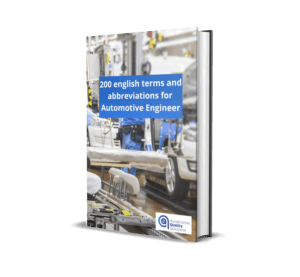During work in the automotive industry, it’s essential to know the terms and abbreviations used in this field.
In the article below, we present the second part of the series related to 50 English terms and abbreviations for suppliers producing components for the automotive industry (the first part is available at the link).
Download our free ebook 200 english terms and abbreviations for Automotive Engineer
We hope it will be a very helpful support during your work.
Advanced Problem Solving (APS): Method for complex problem-solving. Examples include Design of Experiment, Shainin, Six Sigma.
Auto-Quality Matrix (AQM): Tool for QRQC teams, used to analyze not only the causes of problems but also to assess the level of detection and response to errors in the process.
Bill Of Materials (BOM): The composition of raw materials (granules, paint), subcomponents, and the quantities required for producing the final product.
Boundary Samples (BS): Boundary patterns defined mainly for visual inspection.
Continuous Improvement (CI): In the context of Lean methodology, continuous improvement seeks process enhancements in the production plant.
Design Review: Customer and supplier joint reviews prior to “freezing” the mathematical model and tooling kick-off.
Design of Experiments (DoE): Part of Advanced Problem Solving.
Design Validation Phase (DV): The most commonly standardized phase of product development in APQP.
Direct Buy (DB): Term used to refer to sub-suppliers (Tier 2) that the customer has selected to cooperate with during the new launch. Example: A seat supplier must order leather upholstery from a given sub-supplier indicated by the OEM.
Feasibility Assessment (FA): An assessment performed by the supplier, later sent to the client with the rest of the documentation for the project quote (request for quotation documents).
First In, First Out (FIFO): An element of product management in the warehouse.
Fixture: Equipment used to check drawing characteristics on a produced part.
Fault Tree Analysis (FTA): Analysis that reflects the relationship between faults.
Electrostatic Discharge (ESD): Sudden instantaneous flow of electric current between two objects with different electrical potentials, usually created by electrification, caused by direct contact or dielectric breakdown.
Electrical Overstress (EOS): Most often occurs in warranty return analyses for electronic components. It is usually preceded by an agreement with the client regarding decapsulation.
First Part Approval (FPA): Approval of the first good part before starting the production cycle as certification of compliance with the product’s characteristics requirements.
Final Product Audit: Activity performed in the automotive industry, required by IATF 9.2.2.4 Product Audit.
First Yield Rate (FYR): First pass score (e.g., 9/10 – 9 out of 10 pass the first test). One of the production capacity KPIs.
Gage Repeatability and Reproducibility (Gauge R&R): Measurement systems analysis element for determining the repeatability and reproducibility of a given control tool. Part of the MSA AIAG handbook.
Geometric Dimensioning and Tolerancing (GD&T): An approach used to standardize the rules for creating technical drawings.
Human Error Root Cause Analysis (HERCA): Root cause investigation. Used during root cause analysis in Kaizen problem-solving.
Hybrid-Electric Vehicle (HEV): A type of hybrid vehicle that combines a conventional internal combustion engine system with an electric powertrain.
Injection Moulding Machine (IMM): Plastics processing equipment.
Instrument Panel (IP): Dashboard synonym.
Incoming Inspection (II): Activity performed before components are released for production.
Just in Sequence (JIS): The method of delivering components to the production line.
Maturity Level Assurance (MLA): One of the reference manuals from the VDA group related to activities performed during the pre-launch phase.
Measurement System Analysis (MSA): One of the AIAG reference manuals for automotive suppliers.
New Business Hold (NBH): A customer escalation activity where the supplier cannot participate in new business.
Noise Vibration Harshness (NVH): Activity related to the measurement of noise types generated by the final product, usually in a vehicle environment, to correlate noise bands with the EOL (End of Line tester).
Off Tool (OT): The final process in a non-final location (e.g., at the mold tool maker).
Off Tool Off Process (OTOP): The final process in a final location. Parts produced with this equipment status should be used for Product Validation (PV) tests.
On-Job Training: Teamwork observation method at each level of the organization. It allows the supervisor to work directly with the team to improve work efficiency, analyze quality, and eliminate recurring issues.
One Piece Flow (OPF): A production method where products or batches are produced and passed to the next process step one at a time, minimizing buffers between operations.
Overall Equipment Effectiveness (OEE): One of the main production indicators for calculating capacity.
Printed Circuit Board (PCB): One of the electronic components.
Risk Priority Number (RPN): An indicator used to define which activity should be addressed first during FMEA activity as outlined in the AIAG manual.
Root Cause (RC): Activity defined in step D4 of the 8D methodology.
Run at Rate (R@R): A capacity assessment technique used by FORD. Other techniques include 2TP used by VW and CAT – Capacity Assessment (xPRD) used by Stellantis xFCA.
Safe Launch Plan (SLP): Planning for a safe launch in the pre-launch phase and a specific time after the Start of Production (SoP).
Sanctioned Interpretations (SI’s): Sanctioned interpretations of IATF requirements (link).
Shopfloor Layout: Layout of the production hall showing the arrangement of operations and stations.
Supplier Development Engineer (SDE): Engineer responsible for supplier development during the development phase.
Special Characteristics Communication and Agreement Form (SCCAF): A list of agreed special characteristics between Ford and the supplier. This information should be included in the change log during Control Plan definition or update.
Statistical Process Control (SPC): One of the AIAG reference manuals.
Supplier Quality Assurance (SQA): An engineer responsible for suppliers in current production.
Swap Tests: The substitution of a component between the reference part and the part being analyzed to confirm that the defect “follows” the component.
The Way To Teach People (TTWTP): Certification of operator competencies during Kaizen analysis.
Quick Response (QR): Quick response to errors. An element of QRQC problem-solving.
Work Station (WS): Production workstation.
Download our free ebook 200 english terms and abbreviations for Automotive Engineer



